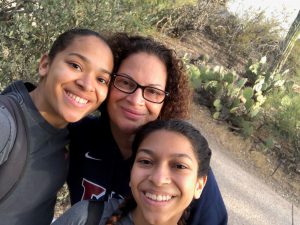The Sun Is My Vice
Posted on byBy Robin Soler

Sun is my vice. It makes me feel good. It’s the root of my family name. Suns hang on the wall in my home reminding me and my children to shine—to be our best. We often speak of “vices” as something that’s okay because we do so many other things right. My vice damaged my skin.
In the 1970s, when I was hanging out on tar beach—the roof of the brownstone I lived in in New York City—using SPF 4 tanning oil while my friends applied baby oil mixed with henna, I thought I was doing well. I fell in love with the sun-assisted caramel color that my Afro Puerto Rican roots blessed me with every summer. As I got older, I took extra efforts to ensure I had sun exposure. I followed most of the skin protection guidelines as they advanced going from SPF 4 to 8 to 15 and eventually 30. When I made it to SPF 30, I discovered I would get a rash when I was in the sun with sunscreen—I would use it, but I wouldn’t reapply.
In 1998, I became a parent. I practiced good sun-protective behaviors with my children, and in turn myself, but I would often get distracted. In 2010, my oldest daughter started running track. We were outside all the time from March through August. She had a huge umbrella and I had an amazing tan. I would slather up before most track meets, then watch her run, jump, and throw all day. If it was raining in the morning, I’d forget. If it rained during the day or I sweat things off, I usually wouldn’t reapply. I love sun and I love a great tan.
In 2012, I noticed a misshapen mole on my right arm. I knew what it was almost immediately. I bought zinc and bandages and covered it up for 2 years. Yes, for 2 years I put my health aside. In 2014, I finally decided to go to a dermatologist.
Diagnosis: Melanoma in situ.*

No surprise. But I was still shocked that my cells could multiply like they did. Cancer is not a thing that runs in my family, and I didn’t have any of the risk factors for skin cancer. Fortunately, it could be cut out, but we aren’t all that fortunate. Right after this “simple” procedure, my heart started racing, and I couldn’t stop shaking. I was reacting to the epinephrine used to increase the effectiveness of the lidocaine. I also discovered I was allergic to the stitches.
Today, I have a three-inch caterpillar scar across my right arm that reminds me of what I’ve been through. I still love the sun, but my skin-protection behaviors are very different. I read sunscreen labels and pay for good product. I use SPF 15 or higher as recommended and have sunblock shirts. I don’t stay exposed for long periods of time and I use my daughter’s giant umbrella. Not perfect, but much better because cancer is real, cancer is dangerous, and even the most basic surgeries can result in unexpected consequences.
*Melanoma in situ is when abnormal melanocytes (cells that make melanin, the pigment that gives skin its natural color) are found in the epidermis (outer layer of the skin). These abnormal melanocytes may become cancer and spread into nearby normal tissue. Also called stage 0 melanoma.
Robin Soler is the mother to two daughters and is the director of the Office of Applied Research in the Center for Preparedness and Response. She has been with CDC for 15 years, primarily in the National Center for Chronic Disease Prevention and Health Promotion as an evaluation team lead.
Posted on by

